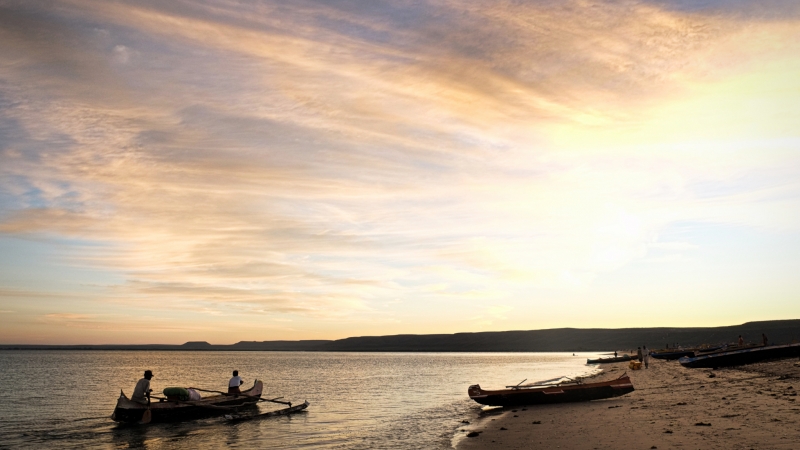Fishers' solution to environmental changes: "let us be guardians of the seas"
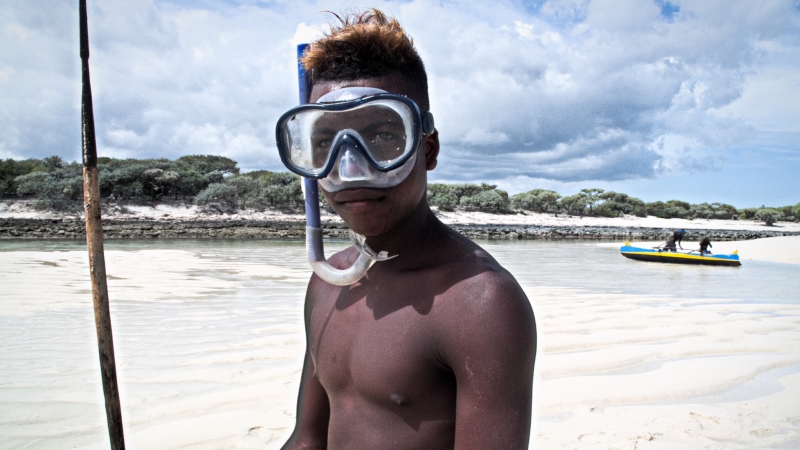
Madagascar’s marine resources are declining. Up to 30% of the worlds fish stocks are caught in unsustainable quantities (Nature, 2017). The reduction in fish stocks are compounded by over-exploitation, pollution, habitat destruction and climate change. For Madagascar where fishing contributes to more than 7% of the national GDP, this is a grave situation. Fishing is the backbone of the economy in rural areas, and acts as the main source of protein for coastal populations.
Fishery stocks in the Indian Ocean are declining at an alarming rate. Little remains in the sea for the fishers of Madagascar. “When I was child, I went fishing with my parents and we used to come back with plenty of fish”, said Samba Lahy, who lives in the southern village called Tampolove. He now returns ashore with only a few fish in hand. At dawn, he used to sail his wooden pirogue out into the vast bay, surrounded by mangroves and palm trees.
“There were many dolphins in the bay then, but today you rarely get to see them. They’ve disappeared, perhaps because of the way we’ve been fishing”, said Samba Lahy.
The ocean’s time of abundance is over. However, like Lahy many of Tampolove’s inhabitants did not abandon the sea, the village, nor their huts, but instead set out to find a solution. The village joined a formal community, and turned to aquaculture for the cultivation of algae. There is a growing demand for this resource, and for now, it appears to be sustainable.
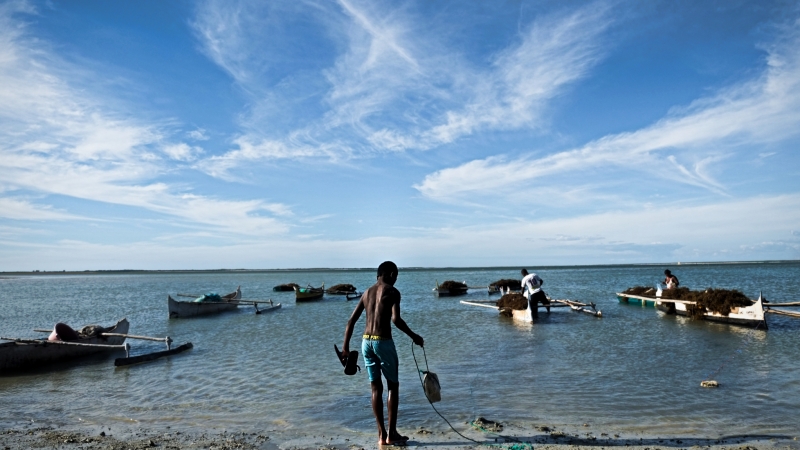
Climate change exacerbates these issues further. According to a United Nations report from 2016, southern regions of the country are suffering severe food shortages, affecting 850000 people and this is projected to persist at least in 2017. As inland livelihoods worsen, many families move to the coast, thus increasing the pressure placed on these communities.
“I don’t know what’s happening, perhaps its a natural phenomenon, however, I do think it is also due to the destruction caused by man. If it persists, many things will change. For example, we are well into the rainy season, but we are yet to receive rain. Both farmers and fishers are in trouble”, said Richard Badouraly, president of the Aquaculture community in Tampolove.
The future for fisheries looks stark particularly when considering the rate of coral reef degradation. “It’s a problem that until now we have over looked, but it is clear: along the entire coast, coral reefs are dying.”, explained Gildas Todinanahary, from the Institute of Fisheries and Marine Science, University of Toliara, Madagascar.
Todinanahary said that the 33 square miles of reef, off the coast of Toliara, is being stripped to nothing but rock. Over the past 50 years 65% of the corals have died.
The loss is due to the increased movement of sediment in the sea, inland drought and over-exploitation by fishers. The fishers gardens – the name given to coral reefs by fishers – are now suffering the same fate as the inland hills, barren and unproductive.
These changes affect fishers the most. With no other options, fishers try to make ends meet by using traditional methods to catch the few fish that are left. Many do not see any alternative way to move forward, nor do they hold out much hope to improve their livelihoods.
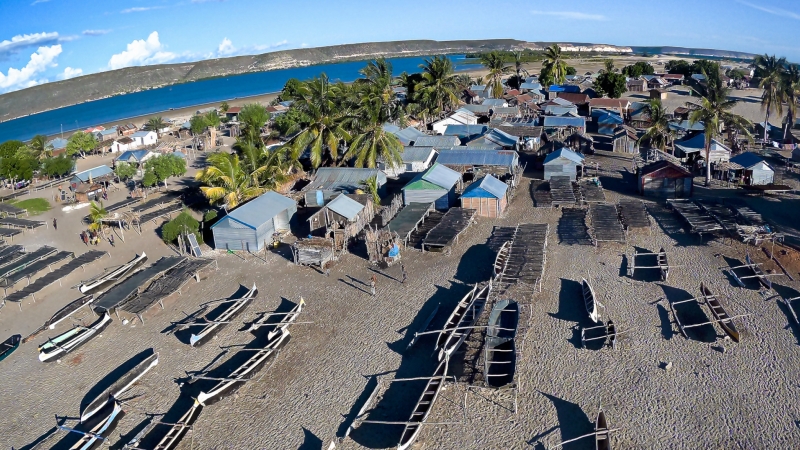
Tampolove's solution
However, there are alternatives, which do provide hope. In the village of Tampolove, a total of 654 people, who’s diet consists predominantly of fish and rice, had a life changing idea that has strengthened their resilience against the dwindling fish stocks. With the support of NGOs and the University of Toliara, the village has formalised a community and now grow algae for the European market.
Fishers are highly observant, so they are very aware of the changes that are occurring, said Todinanahary.
“They need institutions to make it clear that these changes are not always natural. When we tell them this, they themselves will give us the solution”, said Todinanahary.
According to the expert, the sustainable management of small coastal fishing stocks is still possible. The key to this success, as discovered by fishers and interested professionals is a combination of fishing and aquaculture.
In 2010 they formed the Velondriaky community and began running test on the cultivation of sea cucumbers (Holoturia scabra). With little success they moved onto the cultivation of red algae (Kappaphycus alvarezii), from which carragenine, a gel used in the food and cosmetic industry, is extracted.
Velondriaky means “to live with the sea”, and without a doubt the relationship these people share with the sea is insoluble. This same name has been given to the marine reserve that stretches over 1000 square kilometres around Tampolove and other near by villages, with a total population of 7500 people.
In 2005, under huge amounts of pressure, the marine ecosystems collapsed. The government went about setting up marine reserves in a bid to safeguard the biodiversity that remained, in the hope that their coast lines would remain productive. In Madagascar there are now a total of 64 Locally Managed Marine Areas (LMMA) reserves. These include coral reefs and mangrove forests, covering approximately 11% of the coastal shelf. The government has gone one step further and set up the PACP (Projet d’Appui aux Communautés de Pêcheurs) program, which allows local communities to both govern and establish alternative activities in the reserves on which they live. In so doing, villagers are entrusted with the protection and management of their own coasts.
Fishers are at the same time exploiting and overseeing on behalf of the government the marine resources, taking collective decisions on where, when, and how to fish in the depleted coastline of the Velondriaky marine reserve. Self-management, with support of institutions, seems to be the solution proposed to sustainable use of natural resources.
Fishing is regulated within the Velondriaky marine reserve, there are times in the year that fishing is forbidden. Farming plots as well as lines of seaweeds per family are regulated and agreed withing the community.
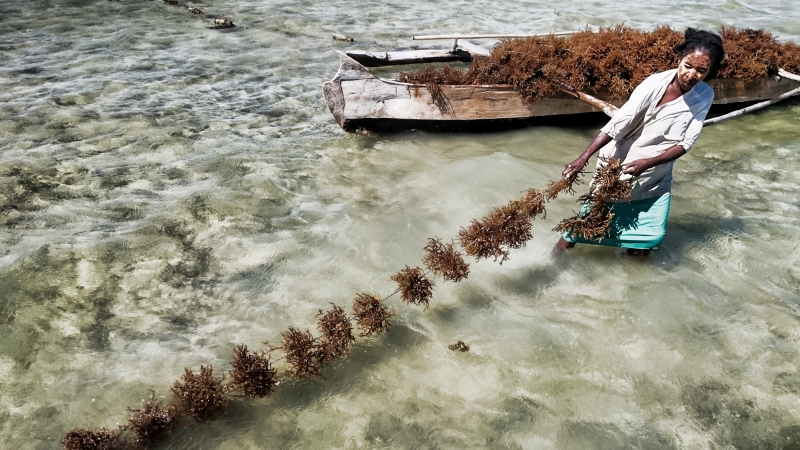
“The fishers understood that they needed to look for alternatives to fishing”, said community leader Badouraly. “With aquaculture a family can earn up to $145 a month to which fish can then be added. Aquaculture has now become a principle activity.”
The production of algae in Tampolove is steadily increasing. The 13 tons of dried algae produced in 2013 has risen to 187 tons in 2016. “We expect to reach 250 tons this year”, said Badouraly. When fishing nets are filled, of course this makes things better, “In the past fishers could earn up to $20 a day. Today, if he’s lucky, he could catch 1/2 kg, which is not enough for family of five or more to survive.”, he said.
With innovation comes new problems. Reducing the number of resources on which they depend to a single species is risky. This very year, for example, their algae was infected by a virus and a large quantity of their production was lost. With the help of foreign NGOs and private companies with a vested interest in aquaculture, the community has now begun cultivating sea cucumbers, which have high commercial value. There are many more opportunities yet to be explored as investigations are already underway into the viability of farming corals and seahorses.
Spherical Image (drag to explore the image). Harvesting seaweeds is a tiring task, often carried out by women (Tampolove, Madagascar. Jacopo Pasotti, 2017)
Sustaining resources from the bottom
Aquaculture has begun to re-shape the structures of families in Tampolove. It has financial liberated women as they are the principle algae farmers, and in so doing given them economic independence. That being said, often the work is done together with the men, who still primarily remain to be fishers.
“This job makes me happy”, said Nariandra Marceline, president of the 67 farmer families belonging to the aquaculture association in Tampolove.
“I can pay the school fees for my children, I hope they study further and will one day work with paper and pen, in an office”,
said Nariandra.
Nariandra has clear ideas on sustainability, it’s all about management. “We have regulations for algae production such as the space that each family is allowed to occupy”, she said. These decisions are discussed and agreed upon as a community.
When larger scale decisions need to be taken, delegates from the surrounding villages, in the reserve, meet to discuss the issues at hand. They then report back to their own villages.
Fishers are highly vulnerable to environmental and societal changes. But they do more than sit and wait for the worst, just as Velondriaky has done many other communities along Madagascar’s coastline have begun to manage their own reserves, protecting their fisheries and securing their livelihoods. In a dialogue with policy makers fishers are trying to adjust to changes, whilst managing their own resources in a sustainable way.
